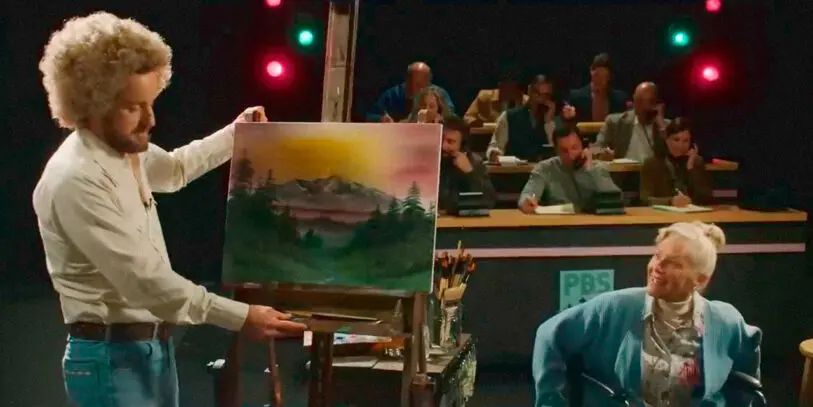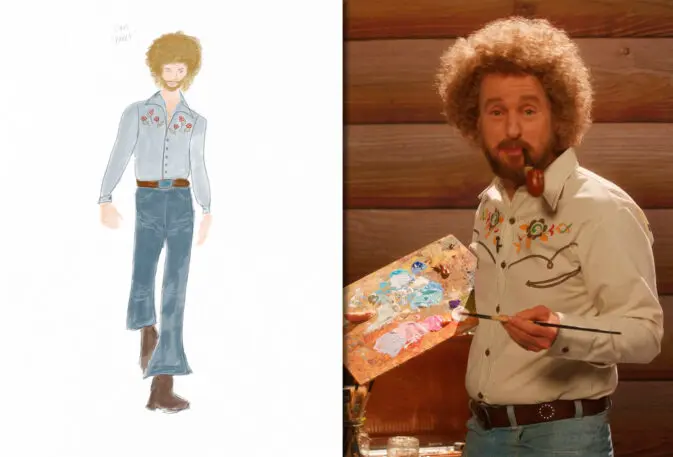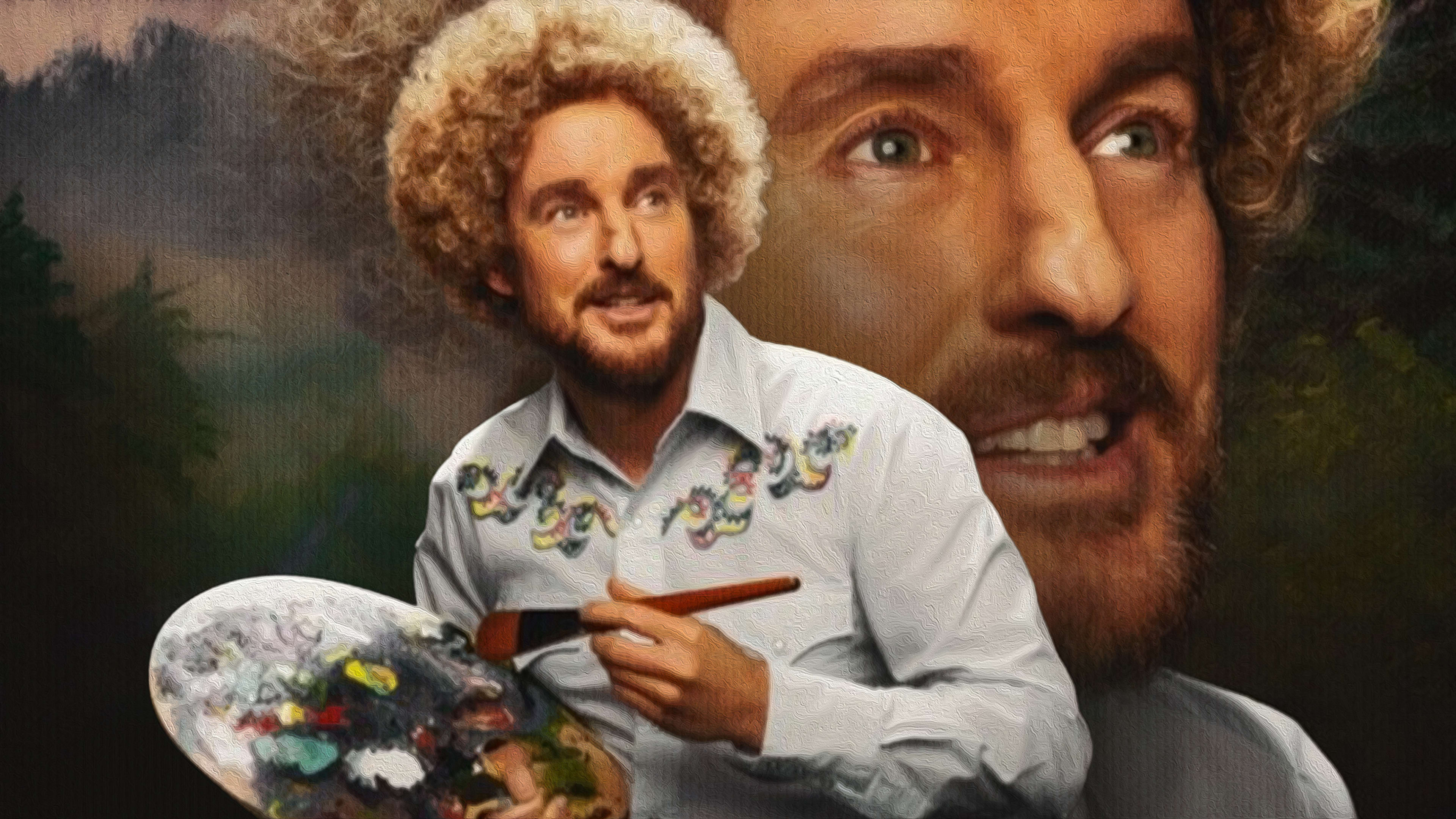Like most of us, Brit Adams felt transported to another state of consciousness while watching Bob Ross on TV, back in the early 1980s. The soft voice, the “happy accidents,” the strokes of burnt sienna, yellow ochre, and phthalo (azure) blue turning into monumental landscapes, were a refuge from the noisy world of his childhood. After each episode, Adams just wanted to stay in that place. Now, about 40 years later, he has realized a feature-length version of his happy place through Paint, his first scripted film.
To be clear, Paint is not about Bob Ross, Adams explains to me during a video interview. The film, which Adams wrote 13 years ago and directed during the pandemic, is inspired by Ross and musician Gordon Lightfoot (whose “If you could read my mind” is key to the film’s climax). From the start, Adams imagined his main character as the anti-Bob Ross. His film turns actor Owen Wilson into Carl Nargle, a man who lives anchored in the ’70s, basking in his former glory, oblivious to the fact that his time has passed. Nargle has Ross’ hypnotic powers of a soft voice and deep gaze. But he uses his magic to his own advantage, womanizing the female employees at the PBS station in Burlington, Vermont, where the story unfolds.
Visually, however, Paint feels like a Bob Ross’ painting. The movie’s first scene opens with a canvas and a brush stroke, pulling viewers through a portal similar to what Ross opened for millions every week during his public-television show, The Joy of Painting. “This world is a bit of a fantasy, but you don’t want it to feel unrealistic or false,” says Todd Jeffery, the film’s production designer. “There was an effort to keep it concise to what tone and feeling we were trying to convey. We’re very much on the canvas—we’re inside of a Carl Nargle painting.”

Layers of brushwork
Every element of the production design—the PBS station, Nargle’s home, his van, his clothes, his hair—are layers in Adam’s cinematic painting. Paint takes place in the 2020s, but Adams asked the film’s design team to lean into using retro clothing, furniture, hair, and set pieces to paint Nargle’s character. They filmed on location in Saratoga Springs, a lovely town in upstate New York that appears as though it’s frozen in time. It feels like the perfect place for Nargle to exist.
Jeffery explains that the office where much of the film takes place was shot at a local Saratoga Springs TV station during COVID, which lent the film a textured realism. The station’s employees left at the beginning of the pandemic, leaving everything behind, so their workplaces were ready to be dressed for filming.

Usually, Jeffery explains, building a set like this would cost a lot of money and time, with the production having to rent or buy heavy furniture like filing cabinets, desks, and cubicle walls. But having it all there allowed them to spend all that effort on finessing the space, building layers on top of it to give it a personality to match Nargle’s. The production design team added custom artwork (like Carl’s paintings and promotional posters), painted some of the walls, and dressed up the cubicles with personal details.

Happy accidents
While filming, Jeffery and his design team encountered what Bob Ross would have described as “happy accidents.” In film, Nargle’s van—one of those classic Ford vans from the ’80s—is an extension of the character’s personality. Its interior, clad in wood and carpet, houses Nargle’s bed, a stereo system, a PA system for talking to pedestrians, and a CB radio, among a dozen other specifics.
Jeffery says Adams had a clear vision for what the van should be: “It needed to be impressive because Carl had really decked it out at one time. It needed to be built out. It needed to be cool. Brit had this idea that it had this mural painting on the side,” he recalls. Jeffery circled that detail when he read the script, knowing it was going to be “a thing.” He was right.
He and his team spent months looking for the right van all around the United States, to no avail. Then, a few days before the shoot started, they found a van two hours down the road from where they would be filming. The van was perfect, but it had to be sent to New York City to get fully wrapped in vinyl to match the script’s original design. Miraculously, says Jeffery, it all worked out: “I think the van pulled up a couple hours before that shot happened.”

Owen Wilson’s transformation
So much of the film’s connection to Bob Ross centers on Nargle’s physical appearance. The hairdo, of course, was fundamental to get the Bob Ross effect Adams wanted. Hairstylist Kekepania Vasquez-Tamali’i fabricated Wilson’s wig by hand. Together with Wilson and Adams, she had to find the right texture, color, and cut to pay homage to the painter. To get that perfect look, Vasquez-Tamali’i made more than 50 adjustments to the wig, completing Wilson’s look with hand-made custom sideburns to match. On screen, it looks perfect. And like everything else in the movie, it has a very specific purpose. Without spoiling the ending, it eventually becomes both a physical brush and a symbol of the character’s evolution.
Costume designer Allison Pearce approached Nargle’s clothing through a similar lens, choosing the 35-plus costumes to serve as a representation of Nargle’s evolution throughout the film. Pearce previously worked as a costume designer for Saturday Night Live, which she says prepared her for this film. “With comedy, I’m always looking for places where you can use the costume as a joke,” she says. “That’s part of the punch line, and I think that was a big part of this film for Carl and all the other characters.”

Pearce drew inspiration from Ross and Lightfoot. “I noticed that Ross always wore quite tight jeans, like very tight-fitting jeans for a painter on television. That was something that went into consideration, like how much chest you see on him,” she says. Lightfoot’s old shirts and jackets were a clear inspiration.

Pearce went on a long journey to complete the looks, finding western shirts that have embroidery on the yoke and front. She augmented all of them, adding her own intricate embroidery to tie them to Carl’s life. “One thing we did was to embroider Mount Mansfield on the front of his shirts,” she says, referencing Nargle’s obsession with painting Vermont’s tallest mountain.

Talking to the crew and the director, you can clearly see the passion that went into the production design of this little indie film. Adams tells me a story that summarizes it well: “Todd, Patrick, and I were walking through [Saratoga Springs] one day, and then Todd was like, ‘Oh, what’s that,’ pointing at a dumpster. It was a cool barber shop tin. So the three of us were suddenly inside the dumpster digging it out. And that tin is in the barbershop in the movie.”
It’s a reminder to—as Bob Ross used to say—“go out on a limb. That’s where the fruit is.”
Recognize your brand’s excellence by applying to this year’s Brands That Matter Awards before the early-rate deadline, May 3.
